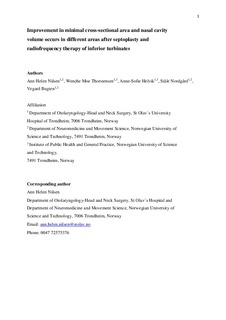Improvement in minimal cross-sectional area and nasal-cavity volume occurs in different areas after septoplasty and radiofrequency therapy of inferior turbinates
Journal article
Submitted version
Permanent lenke
http://hdl.handle.net/11250/2587062Utgivelsesdato
2018Metadata
Vis full innførselSamlinger
Originalversjon
European Archives of Oto-Rhino-Laryngology. 2018, 275 (8), 1995-2003. 10.1007/s00405-018-5022-4Sammendrag
Purpose: Septoplasty and radiofrequency therapy for inferior turbinate hypertrophy (RFIT) are common techniques used to improve nasal patency. Our aim was to compare nasal geometry and function using acoustic rhinometry (AR) and peak nasal inspiratory flow (PNIF) in three patients groups undergoing surgery for nasal obstruction, and to investigate if the improvement in minimal-cross-sectional-area (MCA) and nasal-cavity-volume (NCV) occurred in different nasal cavity areas in the groups. Finally, we evaluated the correlation between the objective measurements and the patients’ assessment of nasal obstruction (SNO). Methods: This prospective, observational study investigated 148 patients pre-operatively and 6 months post-operatively. Fifty patients underwent septoplasty (group 1), 51 underwent septoplasty combined with RFIT (group 2), and 47 underwent RFIT alone (group 3). The minimal-cross-sectional-area (MCA) and nasal-cavity-volume (NCV) were measured at two distances (MCA/NCV0-3.0 and MCA/NCV3-5.2), in addition to measuring PNIF and SNO. Results: Pre-operatively, groups 1 and 2 had narrower MCA0-3.0 on one side than group 3 [0.31± 0.14 and 0.31± 0.14] versus [0.40 ± 0.16] cm2. Post-operatively, total MCA0-3.0 and MCA/NCV3-5.2 increased in group 1. In group 2, MCA/NCV0-3.0 at the narrow side and total MCA/NCV3-5.2 increased, while total MCA/NCV3-5.2 increased in group 3. PNIF improved from 106 ± 49 l/min to 150 ± 57 l/min post-operatively. We found a correlation between increased MCA and NCV and less SNO in the septoplasty group (p<0.01). Conclusion: Surgery produced an improvement in MCA and NCV in all groups. The improvement occurred in different areas of the nasal cavity in the patient groups. Both anterior and posterior areas increased in the septoplasty groups while only the posterior area increased in the RFIT group. PNIF improved in all three patient groups, indicating that surgery produced an improvement in nasal patency.
